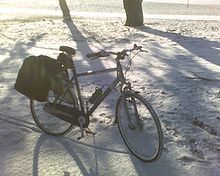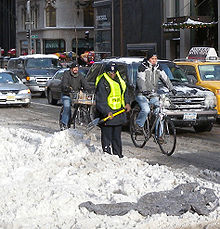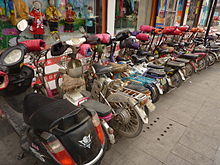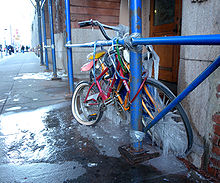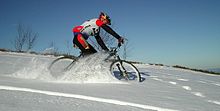- Cold-weather biking
-
Cold-weather biking (also referred to as winter biking, snowbiking or icebiking) is the activity of cycling in winter weather with snow, ice, and slush. As in warm months, people bike in cold-weather for several reasons. Bike commuters cycle to work for exercise, to reduce their carbon footprint, or to save on the costs of parking, amortized car purchase (by making less frequent), car maintenance, insurance, and fuel. Recreational snow or ice-bikers include off-road bikers who ride on snowmobile trails with underinflated, fat tires and ice-bikers who use frozen streams, ponds, or rivers, or who race on iced-over lakes.
Winter roads may have less space for cars and bicycles to share, when snowbanks line the roads. To maintain control of a bike on icy roads, cyclists need a different riding style than they would use in summer. Bikers tend to ride more slowly and cautiously, be more upright on turns, and avoid using the front brake on icy roads, because front braking can lead to skidding and crashing.
Cold-weather bikers usually wear several layers of protective clothing to keep warm, including insulating layers such as merino wool and wind- and water-resistant outer shell layers. Protecting the extremities (feet and hands) from the potentially frostbite-causing effects of subzero windchill is a particular challenge, as is keeping wind off the face.
Some cold-weather bikers use special bike gear to deal with the inclement weather, such as metal-studded tires to improve traction, enclosed chain cases and internal hub gears to shield the drive train from ice, and hub brakes or enclosed drum brakes, which can operate even when the wheel rims are caked in ice. Bikers may have to clean caked-on ice and snow from brake pads, rims, and derailleur cassettes during and after a ride, to remove corrosive road salt and metal-wearing grit and sand from chains and derailleurs.
Contents
Techniques and equipment
Staying warm
Types of climates and riding
Winter cyclists in different climates use different types of clothing. In cool, wet winter climates in coastal areas such as Oregon, Scotland, and Maine, there is a great deal of cold rain and heavy, thick snow, and periods of quickly forming ice. Cool dry prairie areas have high winds and drifting snow. Very cold areas such as Canadian prairies, Interior Alaska, Greenland, Interior Norway, and Finland have dry powdery snow, gusting winds, and extreme wind-chill effects.
Another consideration is the length of the ride, and the remoteness of the setting: whether it is a 30-minute commute in a city or a day-long outing in a wilderness area. In a city area, a winter biker with a flat tire or mechanical problem can warm up at a fast-food restaurant, lock up the bike and get home in a bus or taxi. A winter biker in a wilderness area, dismounting to solve a mechanical problem, may get dangerously chilled during this period of inactivity.
In moderate winter climates, such as in the US Midwest, the main cold issue faced by winter bikers is keeping the extremities (feet and hands) warm. In these climates, the body core and limbs can be kept warm fairly easily by layering insulation layers and wind resistant shells. In more extreme winter climates, such as in northern Canada, Alaska, and Scandinavian countries, where winter temperatures may drop to -30 Celsius or lower, it can be more difficult to keep warm while winter biking. Thick, insulated winter outerwear designed for other winter sports may help.
The amount of insulation needed depends on exertion level and metabolism, and so typically must be determined by experimentation by each individual. Typically the right amount leads to feeling slightly cold for the first few minutes, after which the exertion leads to a comfortable temperature. In winter weather, it is important to stay dry, because the body loses heat faster when wet. Moisture may self-generated from perspiration, or may come from icy rain or slush thrown up from the road.
Outerwear and accessories
Further information: Layered clothingTo avoid getting chilled from perspiration, winter cyclists should wear clothing in layers, so that they can remove outer shells as they become warmed up. As well, the type of material is important. Cotton absorbs perspiration readily and loses its insulation ability when wet, and it dries slowly. Both wool and synthetics such as pile and fiberfill retain much more of their insulation capability when wet. Inexpensive waterproof shells may not be able to vent moisture properly, as a basic uncoated shell or a more expensive waterproof-breathable shell can do. It is hard to keep the feet dry, because they are constantly being sprayed with tire spray and spray from passing traffic. This can be remedied with fenders, shoe covers, and Gore-Tex sock liners.
Keeping feet warm can be more difficult than in other activities such as snowshoeing or cross-country skiing, because the feet tend to be less active in cycling. In areas with moderate winter temperatures, ice bikers may wear sandals with a number of layers of wool socks. In colder climates, cyclists may wear thermal overshoes, thick snowmobiling boots, or oversized shoes with several layers of thick socks. Another option is to use battery-operated electrical foot warmers or chemical heating pads.
Keeping hands warm can also be challenging. This may be because a tight grip on the handlebars and brakes both inhibits circulation and allows heat conduction into the ice-cold handlebars. Types of gloves and mittens are discussed in a separate article. If it is really cold, some cyclists use pogies—insulated covers that fit over the handlebars of a bicycle. The rider puts the hands into the open end and has full access to the bike’s controls. The rider can use pogies either barehanded or with normal riding gloves. They are a common sight in Alaska during the winter.
Keeping the head and face warm is challenging because of wind on the face and because a helmet is often worn for safety, but bicycle helmets are usually designed to maximize ventilation for hot-weather use. Helmet covers can be used to close the vents. A thin knit cap or technical beanie can fit under a helmet to increase insulation; thicker insulation under a helmet requires adjusting the helmet or switching to a larger size helmet. Balaclavas made for use with helmets that have a thin top portion and a thicker lower portion can be useful.
Many winter bikers use ski helmets, which often have adjustable ventilation and come with warm linings and ear flaps, and are designed for use with ski goggles. Ear flaps are also available for bicycle helmets. Ski goggles and neoprene face masks are useful for keeping the face warm and protecting from frostbite in very cold weather. In very cold climates with extreme wind chill effects, a snowmobiling helmet with a face visor may be used. Snowmobiling helmets are preferred to motorcycle helmets because they have features designed to prevent fogging of the face shield.
Control and braking
To maintain control of a bike on icy roads, cyclists need to use a different riding style than they would use during summer months. In the summer, cyclists usually turn by shifting their body weight and "leaning into" a turn. On an icy road, angling the bike even to a small degree may lead to a loss of control and a fall. As a result, winter cyclists riding on icy roads tend to ride more slowly, and more upright on turns.
As well, on icy roads, riders need to change how they use their brakes. In summer weather, on a dry road, a cyclist can stop quickly by using both brakes, with much of the braking accomplished by using the front brake. In the winter, the brake pads and rims may be covered with slush and snow, which means that it may take a lot longer to stop the bike. As well, on an icy surface, any use of the brakes, particularly the front brake, can lead to a loss of control and a fall onto the roadway. Some winter cyclists prefer to use the rear brake, which tends to cause a controllable skidding effect on an icy road. When a bike goes into a skid during rear-tire braking, the skid can be controlled by easing up on the rear brake and by using a foot as a stabilizer or "outrigger."
In some extreme conditions, such as black ice, any use of the front brake may lead to a loss of control. In these conditions, it is best to use the front wheel for steering, and use the back wheel for cautious braking.
For riding on ice, studded tires greatly increase control. Turning or braking on ice without studded tires can easily lead to falling. Nokian Renkaat, Bike Nashbar, Innova, Schwalbe, Kenda and Continental supply studded bicycle tires. On snow, studded tires are not needed, except for the possibility of hitting icy spots which are hidden by snow. In deep snow, wide, low-pressure tires, sometimes on special wide rims, improve the ability to "float" on the snow. With relatively little snow on the pavement, narrow, high-pressure tires can "cut through" the snow and grip the pavement better.
Visibility
Winter brings shorter daylight hours which frequently means riding in dusk or dark conditions. Winter weather such as snow flurries and blowing snow can make it harder for drivers to see cyclists. Moreover, windshields and side mirrors may be obscured by ice and snow, and the inside of the windshield and rear window may be fogged, which makes it even harder for drivers to see cyclists.
There are two approaches that winter bikers can use to deal with the fact that drivers have reduced visibility. The first strategy is to use vehicular cycling techniques, including taking control of the lane[1] when appropriate, hand signals, and more.
The second strategy for being more visible is to use lights, reflectors, and other items. Rear and front lights and reflective tape applied to the helmet, clothing and bicycle can greatly increase your visibility to drivers on the road. Reflective orange and yellow vests such as those made for construction workers can make a cyclist much more visible in the winter, not just in the dark, but also in the daytime. Lights with external rechargeable batteries such as those that fit in the bottle holders offer much better visibility than smaller, self-contained ones. Some cyclists also use safety flags, either mounted on horizontal fiberglass stems (which encourage drivers to leave more space when passing), or on vertical fiberglass poles (which makes the cyclist easier to see in heavy traffic).
Effects on bicycle
Salt and sand
In many parts of Canada and the northern US, municipal governments use salt, sand, or gravel on the roads in the winter. Salt corrodes unprotected steel rapidly, and wet sand and gravel can clog moving mechanical parts. This is particularly a problem for chains and other exposed drivetrain parts. Winter cyclists may have to clean and re-lubricate their chain and drivetrain much more frequently in the winter. During periods of wet, rainy weather, when the roads are filled with road salt-filled slush, the chain and drivetrain may needed to be re-oiled every day. A front fender with a large mudflap helps decrease the amount of salt spray, gravel, and other debris reaching the chain. Bikes without derailleurs (single-speed or with internally geared hubs) can tolerate more chain wear, and so can be a good choice. They also work well with chainguards or totally enclosed chain cases, which can protect the chain. "Rustbuster"-coated chains and stainless-steel chains are more resistant to corrosion.
Snow and ice
After a bike is ridden in snow and slush, it quickly becomes caked with ice. The bike will work better if the bike can be brought inside to warm up once a day, so that the ice can melt off. Once the ice has melted, the bike should be dried, and the mechanical components should be cleaned and re-lubricated. The least expensive way of lubricating a bike is with oil lubes, which also have the benefits of not freezing displacing water. However, oil collects dirt and debris such as road sand, which will wear down the chain and sprockets over time.
Another problem with winter biking is very poor or even non-functional shifting with the derailleur systems. This may be due to the water in the brake and dérailleur cables freezing or due to salt water that has caused the cables to corrode and rust. These problems can be remedied by using expensive Teflon-lubricated cables, by using fully jacketed cables (which are sealed and lined) or by using a dry wax lubricant such as White Lightning. Some winter bikers bring the bike inside a heated building after each use; while this may resolve the problem of frozen cables, it is likely to accelerate the problem of rusted cables, because the slush thrown up onto the cables often contains road salt.
Suspension and tyre pressure
A large change of temperature between warm interior and cold exterior causes changes to air pressure in tyres, air suspension dampers in forks and rear-stays and low temperatures also have an effect on viscosity of oil in liquid dampers, which will suffer from low performance. Slight overpressure in tyres and air suspension at room temperature will compensate the pressure drop due to low temperature. A winterized thin version of damper oil ought to be used in liquid dampers as well as in wet internal gear hubs e.g. Shimano Alfine & Rohloff Speedhub.
Water canteen a.k.a. Bidons
Water below freezing temperature becomes solid and hence impossible to get out of water canteens. Vacuum canteens or insulated versions can extend the period when water stays liquid. Similarly, backpacks with water bags need to have some insulation as well as the PE hose delivering water to the mouth.
Bicycle selection
Because of the effects of salt and sand, winter bikers generally avoid using expensive lightweight bicycles. As well, the precision mechanics of an expensive bike can be of little use in a winter biking setting, when the derailleurs are caked with chunks of ice and the cables are shrouded in ice. Where salt and sand are not used as heavily, some winter bikers use the same bike they ride throughout the year.
Older mountain bikes or hybrid bikes, colloquially called "beaters", are a popular choice. Some high-end commuter bikes are available with internally geared hubs and chainguards or cases. Some users prefer drum brakes, which are totally enclosed in a metal drum, protecting them from wet, slushy weather.
The effects of wear can be mitigated by frequent cleaning of the chain and other exposed drivetrain parts. Aluminum frames are preferable, being less susceptible to corrosion than steel. While not as important as the drivetrain, aluminum frames should also be cleaned frequently. Mileage will vary greatly depending on specific winter conditions. A single-speed or fixed gear bike offers the advantage of having no derailleurs to become clogged with snow or gear shift cables to become frozen with ice. A fixed-gear bike allows the rider to gauge traction through the rear wheel, which is beneficial in slippery conditions.
Types
Types of winter biking include road biking for sport or utilitarian purposes such as commuting; trail or mountain bike riding (usually on snow); and riding on frozen lakes and rivers.
Commuting
People use their bikes to commute for a number of reasons. In some cities, traffic is so congested that it is faster to commute by cycle. Another reason for commuting by bike in the winter is that it can be easier and less expensive to park a bike in a downtown area than a car. Other winter cyclists may use their commute as a way of getting exercise, or as a way to be environmentally friendly.
Winter commuting in areas that get snow and ice poses several challenges. In the winter, snow is plowed to the side of the road, which often covers the shoulder of the road and makes the available road surface more narrow. As a result, cars and bicycles have less space to share on the road. As well, winter cyclists have to travel in a variety of conditions which change greatly between a morning and evening commute, from freezing rain to gusting icy winds. As a result, a winter biker may need to bring a variety of clothing in order to be prepared, such as additional outerwear and goggles.
Depending on factors including the climate, the length of the commute, and the plowing schedule, some winter bikers wait for the streets to be plowed before setting out. Other winter bikers bike through snowdrifts, which takes a great deal of energy, as a way of getting a vigorous workout.
Off-road riding
Off-road biking on snow is easiest on well-packed snow such as snowmobile trails. To ride off-road, many cyclists use mountain bikes that can be mounted with wide tires, and the tires are often underinflated, so that more tire surface will be in contact with the road. Some off-road cyclists use expensive specialty tires which are designed for very low inflation pressure, as little as 20 PSI (1.3 bar).
Winter bikers often ride on frozen lake or pond surfaces. They can also use the winter ice cover of some rivers, streams, and wetlands to explore areas which are otherwise inaccessible to bicyclists. To gain traction, ice-bikers either use commercially available studded tires or make their own DIY studded tires by drilling screws into the tire and padding the inner tube with duct tape. To add stability, some ice-bikers add outriggers to their bikes.
See also
References
- ^ "How Safe is Cycling in Wet or Cold Weather?". Cold or Wet Weather Cycling. City of Ottawa. http://www.ottawa.ca/residents/onthemove/travelwise/cycling/weather/how_safe_cycling_wet_cold_weather_en.html. Retrieved 7 September 2011. "In the winter, roads tend to be a bit narrower due to snow banks, so 'take the lane' if necessary, by riding in the middle. This will prevent any motorists from passing you too closely."
External links
Categories:- Winter sports
- Cycling
Wikimedia Foundation. 2010.

